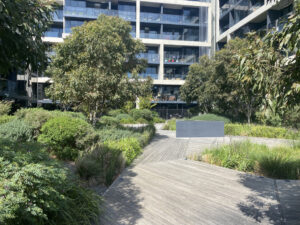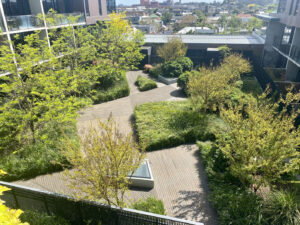
Designing green spaces benefits and strengthens community
By Michael Casey
The benefits of green spaces are well documented but the many and varied tangible benefits they provide is where we need a greater understanding to assist us in identifying and undertaking more robust design and advocacy practice for green spaces.
On the back of my last article that highlighted just some of the environmental, economic and social benefits that green infrastructure can provide, and the documented return on the investment from these projects, I couldn’t help but think we’d only scratched the surface of the topic and that there was more opportunity to explore this further.
Green everywhere, for everyone!
Based on the three pillars of sustainable green space design, and with a focus on social benefits and returns at a suburban level, this piece delves into the design principles that could, and should, be applied to benefit the people who live in suburban environments. Additionally, with the social benefits and returns that can be experienced and realised in many forms, with monitoring the success of general health and well-being of people in these spaces is of particular importance, especially in understanding the activities carried out that can lead to this state. An existing project I’m involved in has moved from designing and redeveloping existing green spaces inside the building, to looking at ways to improve the outdoors that will ensure maximum benefits for the community. The inner-city apartment block consists of three green roofs, apartment gardens and green spaces around the perimeter of its 12000m² space. The design brief from the residents and committee stated that the existing spaces needed to be improved to deliver maximum benefits for the owners of these apartments. This went one step further to incorporate green spaces outside of the building itself which means the local community also stand to use and benefit from the new addition. This approach of utilising an asset to benefit the community meant that the social benefits could be maximised for everyone.
Green suburban characteristics
When suburbs provide access to green spaces, trees and access to open spaces, the residents, based on current studies are identified as being healthier and happier than residents of suburbs that lack this critical infrastructure.
They tend to have lower levels of crime, are more productive, rely less on public health services and tend to enjoy physical activity. These suburbs can be characterised as cooler, cleaner, well maintained, have lower noise pollution and the residents can breathe easier with lower levels of polluted air.
While these benefits are all measurable on a large scale and beneficial for the residents of these ‘green’ suburbs, there’s also a need to identify how contemporary design principles are incorporated on a smaller and localised scale, much like the inner-city apartment block that was referenced, and also to socialise the principles and benefits with key stakeholders, including local council, to realise the true potential.

The design for the greater ‘green’ good
The beautiful tree lined street where the inner-city apartment block is located, hosts several mature Plane trees that are underplanted with a lawn that suffers in the heat of summer and does nothing to enhance the landscape, the adjoining cafe nor the entrance to the apartment block. The entrance will soon be turned into a series of bench seats and tables that neighbours can picnic at, or stop and sit and enjoy the shade on the warmer days.
The existing nature strips that currently consume a lot of energy via maintenance, repairs and the use of machinery will be transformed into urban food spaces. These spaces will produce an abundance of produce. Even though it will be plentiful inside the apartment block, the outer food garden, upon completion, will be transformed to urban farms where the excess produce will be grown for the community, and signage for these beds will educate and encourage residents to reap the benefits by way of education, food supply and inclusivity.
There is also now a plan in place to engage the local indigenous community to assist with the set-up of garden beds to dedicate to ‘bush foods’ and local indigenous plantings that can be used as a teaching aid for residents to learn more about these culinary and local growing treats. There really is no better way to spend parts of the day sitting under the mature trees having a picnic with fellow neighbours, all while consuming locally grown foods.
The harsh and hot surrounds of the concrete and brick building is accentuated by the hotter surface of the large bitumen footpaths. These areas have now been highlighted as having the potential to house containerised plantings to add to the landscape, soften the outside facades and also continue the green link around this building. This green link, created from tree lined suburban streets through this landscape and then beyond, was commented on by a resident who felt that this could be a perfect way for residents to walk to their local coffee shop or use as an alternative walking track and to enhance their contact with nature while on their walk.
Promotion of physical health can be enhanced by providing green spaces for people to see and experience when out walking or running. Hopefully this would then encourage others, including council, to create a green link that may even stretch beyond this suburb and be marketed through a series of maps promoting green walks.
Sitting and resting in these open spaces will be enhanced around the perimeter of this building to ensure residents have a place to retreat to on hot days and laze about in the shade of the existing trees. Interconnectedness has many social benefits and none more so than the contact neighbours can have with each other both through social interaction and passive and active activities. To welcome people into your landscape has traditionally been discouraged by property owners, however, in this prime example, the residents will not only have a true experience inside this green space but will appreciate the beauty of it from their own houses. A true ‘borrowed’ landscape on many levels.
The future is green ‘spaces’
With an ever-growing population in the city, the ongoing process of urbanisation will, if not monitored and managed correctly, will consume large amounts of green spaces along the fringes of our cities and forever change the current internal green space pattern. These concerns and real issues that need to be addressed with attention directed at maintaining and regenerating urban green spaces, and most importantly push the boundaries on greenspace potential and how they will integrate and benefit into our built landscape.
The examples in this article highlight how providing urban green spaces in the city is an important strategy to maintain social sustainability through opening opportunities to socialise, participate in physical activities, aesthetic enjoyments and education.
Michael Casey MAIH RH
Director of Evergreen Infrastructure and MJC Horticulture,
National President of Australian Institute of Horticulture
Council member with Interior Plantscape Australia.
E: president@aih.org.au or Michael@evergreeninfrastructure.com.au
